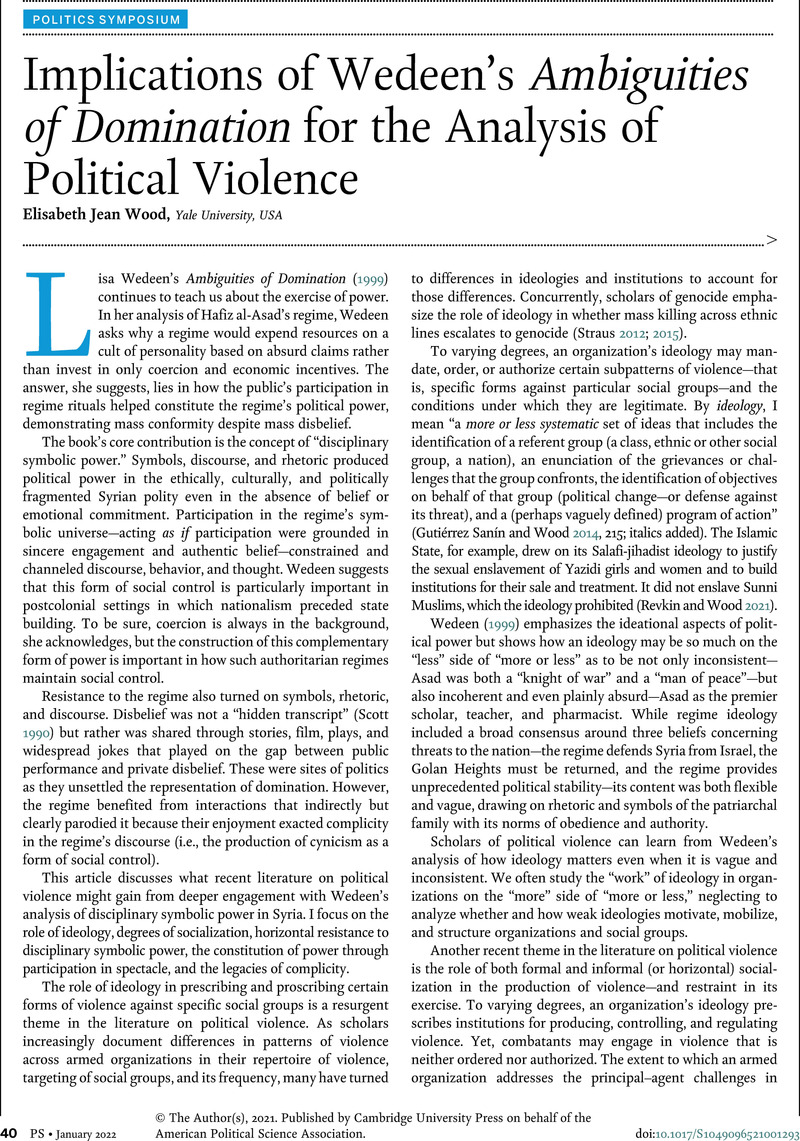No CrossRef data available.
Article contents
Implications of Wedeen’s Ambiguities of Domination for the Analysis of Political Violence
Published online by Cambridge University Press: 21 December 2021
Abstract
An abstract is not available for this content so a preview has been provided. Please use the Get access link above for information on how to access this content.

- Type
- Twentieth Anniversary of Lisa Wedeen’s Ambiguities of Domination: Politics, Rhetoric, and Symbols in Contemporary Syria
- Information
- Copyright
- © The Author(s), 2021. Published by Cambridge University Press on behalf of the American Political Science Association
References
REFERENCES
Bell, Andrew, and Terry, Fiona. 2021. “Combatant Rank and Socialization in Norms of Restraint: Examining the Australian and Philippine Armies.” International Interactions. DOI: 10.1080/03050629.2021.1881085.CrossRefGoogle Scholar
Fujii, Lee Ann. 2021. Show Time: The Logic and Power of Violent Display. Ithaca, NY: Cornell University Press.Google Scholar
Gutiérrez Sanín, Francisco, and Wood, Elisabeth Jean. 2014. “Ideology in Civil War: Instrumental Adoption and Beyond.” Journal of Peace Research 51 (2): 213–26.CrossRefGoogle Scholar
Hoover Green, Amelia. 2017. “Armed Group Institutions and Combatant Socialization: Evidence from El Salvador.” Journal of Peace Research 54 (5): 687–700.CrossRefGoogle Scholar
Hoover Green, Amelia. 2018. The Commander’s Dilemma: Violence and Restraint in Wartime. Ithaca, NY: Cornell University Press.Google Scholar
Kelman, Herbert C., and Hamilton, V. Lee. 1989. Crimes of Obedience: Toward a Social Psychology of Authority and Responsibility. New Haven, CT: Yale University Press.Google Scholar
Manekin, Devorah. 2013. “Violence Against Civilians in the Second Intifada: The Moderating Effect of Armed Group Structure on Opportunistic Violence.” Comparative Political Studies 46 (10): 1273–300.CrossRefGoogle Scholar
Revkin, Mara Redlich, and Wood, Elisabeth Jean. 2021. “The Islamic State’s Pattern of Sexual Violence: Ideology and Institutions, Policies and Practices.” Journal of Global Security Studies 6 (2). DOI: 10.1093/jogss/ogaa038.CrossRefGoogle Scholar
Scott, James. 1990. Domination and the Arts of Resistance: Hidden Transcripts. New Haven, CT: Yale University Press.Google Scholar
Straus, Scott. 2012. “Retreating from the Brink: Theorizing Mass Violence and the Dynamics of Restraint.” Perspectives on Politics 10 (2): 343–62.CrossRefGoogle Scholar
Straus, Scott. 2015. Making and Unmaking Nations: War, Leadership, and Genocide in Modern Africa. Ithaca, NY: Cornell University Press.CrossRefGoogle Scholar
Wedeen, Lisa. 1999. Ambiguities of Domination: Politics, Rhetoric and Symbols in Contemporary Syria. Chicago: University of Chicago Press.Google Scholar
Weinstein, Jeremy M. 2007. Inside Rebellion: The Politics of Insurgent Violence. New York: Cambridge University Press.Google Scholar
Wood, Elisabeth Jean. 2018. “Rape as a Practice of War: Toward a Typology of Political Violence.” Politics & Society 46 (4): 513–37.CrossRefGoogle Scholar
Wood, Elisabeth Jean, and Toppelberg, Nathaniel. 2017. “The Persistence of Sexual Assault within the U.S. Military.” Journal of Peace Research 54 (5): 620–33.CrossRefGoogle Scholar




